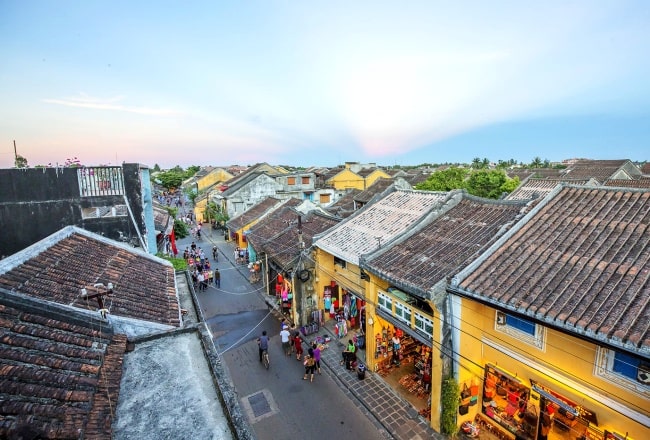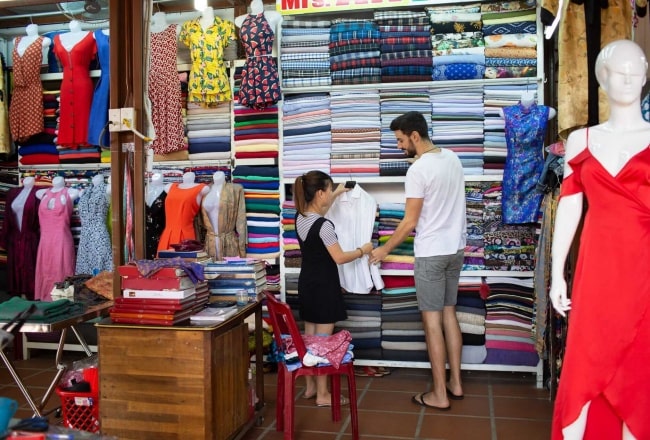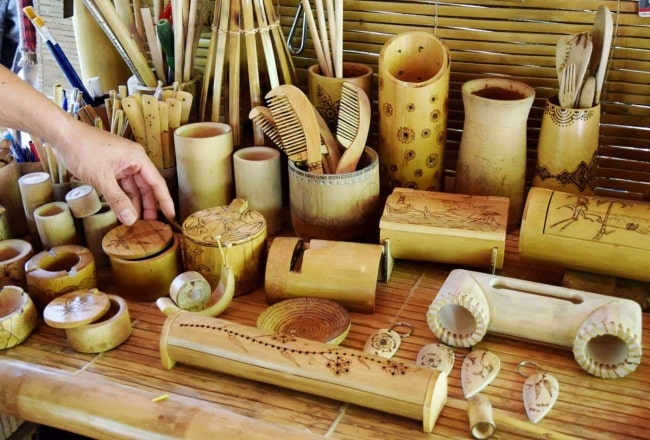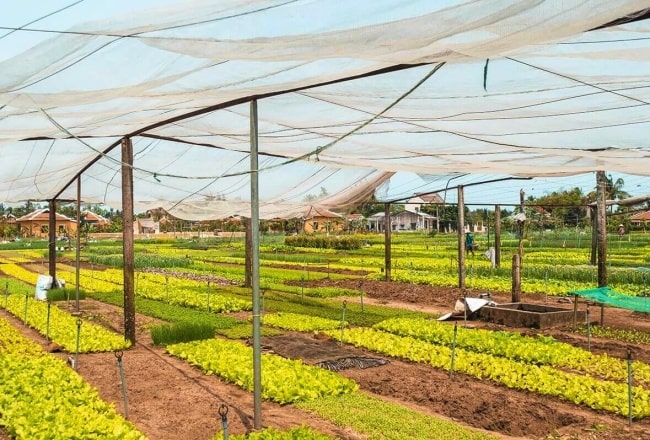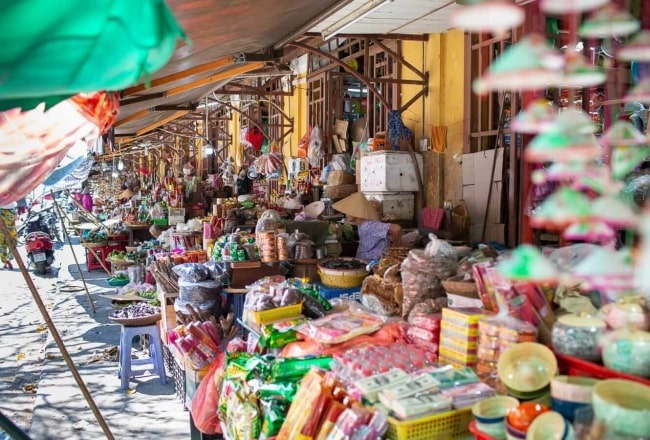Hoi An Weather Overview
Hoi An belong to Quang Nam province which mean the city is characterized with climate patterns of central Vietnam which is different with both other climate areas – northern Vietnam and southern Vietnam. If Hanoi weather and other cities in northern Vietnam have 4 seasons with a chilly winter, central Vietnam and Hoi An only have two seasons with a warm weather all year round, averaging 29 degree Celsius.
However, the two seasons in Hoi An have so much influence to tourists’ traveling experience because the change is drastic and the impact is constant.
Dry season in Hoi An lasts from May to September with hottest months June and July, reaching 38-40 degrees Celsius during daytime. In this season, the rain is much less, and humidity is even lower.
The wet monsoon season, as you can see, falls in between October to January, making December also a month of wet season. In this season, Hoi An suffers from constant showers which frequently lead to flooding. Typhoons can also happen in this time of year, especially in October.
From December to January, the rains ease up but expect everything still to be damp and musty. Temperature reach the lowest with only 19 – 24 degree Celsius. Evenings are cooler and you should prepare thicker jacket if you want to go out for a walk until late.
Check the below table to have the general idea of Hoi An weather throughout the year.
| Month | Avg. High (°C) | Avg. Mean (°C) | Avg. Low (°C) |
|---|---|---|---|
| Jan | 24.4 | 21.2 | 18.6 |
| Feb | 26.6 | 22.8 | 19.9 |
| Mar | 28.4 | 24.6 | 21.7 |
| Apr | 31.1 | 26.8 | 23.5 |
| May | 34.1 | 28.8 | 25 |
| Jun | 35.2 | 30 | 25.9 |
| Jul | 34.6 | 29.4 | 25.3 |
| Aug | 34.1 | 29.1 | 25.2 |
| Sep | 32.2 | 27.7 | 24.2 |
| Oct | 29.7 | 26.1 | 23.1 |
| Nov | 27.9 | 24.8 | 22.2 |
| Dec | 25.5 | 22.4 | 19.9 |
Best time to go to Hoi An
The best time to visit Hoi An is from February to June. February to April is the time of comfortable temperatures, low humidity, favourable sunshine hours and balmy sea temperature. May, June and July are also an excellent time to visit this ancient seaside town. These months don't receive heavy rainfall, but the temperature tends to go up a little during this time, and hence might turn a bit uncomfortable for visitors.
Hoi An has two distinct seasons: the dry, and the wet seasons. The temperature throughout the year almost remains the same, which is, an average of 29°C during the peaks of the day, and around 24°C after sundown. August marks the advent of the wet season. Temperatures, as well as rainfall, varies drastically during this period, which runs through October. With the temperature reaching as high as 38°C (100°F), July and August are the hottest months of the year. October and November are the wettest months of the year, while November, December, and January are the coldest. Temperatures during this time range from 19 to 24° C.
Hoi An Seasonal Weather Guide
The Dry Season
This is defined as the months with the least rainfall along with a lesser chance of all-day rain days. However, there are still rain days.
The total length of the dry season typically stretches from February to September, but within this timeframe, it has its fluctuations. February to April has the most moderate temperatures averaging a high of 30°C (86°F) making it a popular choice for tourists to visit the ancient city of Hoi An.
Moving on from May, the temperatures continue to rise and hit a peak in June. Things then plateau until September when the seasons change. If you need to cool off during this time Hoi An’s beaches are a great option. Check out our article on them here.
Hidden Hint: If you’re looking for sunshine weather in Hoi An, the highest number of sun-hours are from May to July.
The Wet Season
This is defined as the months with additional rainfall along with a higher chance of rain days. However there are still some sunny days. This season starts around October and lasts till around February.
From October to January, the wet season brings increased rainfall and the temperatures down to around an average high of 25°C (77°F).
Hidden Hint: The months of October and November contain the bulk of the rain, and it’s not unusual that during this time the Old Town and the islands south of it have the possibility of flooding.
While it doesn’t often happen, when it does the waterfront businesses have no choice but to close down. However, as quickly as the water levels return to normal, so do the shops.
Both the wet and the dry seasons don’t leave much of a shoulder season for residents. (A “shoulder season” being the months that have equal, rainy, and dry days.) In Hoi An, it’s one or the other weather-wise! The only variable is when they tend to start and end. This period only shifts by a month or so.
Adverse Weather – Flooding in Hoi An
Although flooding doesn’t happen every year, it is something to be aware of when planning your trip during the rainy season. Flood levels vary, mostly it’s restricted to the Old Town and immediate surrounding areas, some years it experiences knee-high water, while others it has received multiple metres. It’s best to check the weather forecast ahead of time if you expect to travel to Hoi An from October to December. Here is a related article about An Bang Beach which you can read.
If flooding does occur during your time in Hoi An, know that the locals are super adaptable and prepared—the weather won’t bring your travels to a full-stop. Many riverside businesses in the old town stack up their chairs and move their valuables upstairs to get ready for the flooding.
Interestingly, you may even notice that some shops have flood levels from previous years marked on their walls. Depending on the severity, only a portion of the city is affected by the flood, and even so, the shops and especially restaurants are usually back in business within a day or so.
Furthermore, it’s an incredibly unique experience to be in Hoi An during this time. Imagine locals paddling their boats through the picturesque laneways of Old Town! Flooding can happen, but life in Hoi An carries on.
Month By Month Weather in Hoi An
The following is a month-by-month weather breakdown for Hoi An. Hidden gathered the average climate and conditions for Hoi An from 1985 to 2017 and the close surrounding areas. It’s a great way to set your expectations in preparation for an upcoming trip to Hoi An.
January
High: 25°C (77°F)
Low: 19°C (66°F)
Rain Days: 13
The wet season that started in October is finally on the way out but still has the chance of making itself known as a final reminder. It is wise to pack for all weather conditions as a sunny cycle ride can quickly turn into a race for shelter from the rain.
Hidden Hint: Bring some light rain gear if you think you are planning to be here early in the month. If you forget, that is ok, Hoi an and Da Nang have some great shopping for jackets and more.
February
High: 26°C (78°F)
Low: 20°C (78°F)
Rain Days: 7
February is a great month to visit Hoi An. The dry season will be starting or already has, and this means more beach days for you. Along with this, the temperatures have not hit their high points, meaning you can expect lovely moderate days and nights in the Old Town.
Depending on the lunar calendar, Tet (lunar new year) may happen during February. For the Vietnamese people, Tet is the most important festival of the year so travel around this time is expensive, unstable, and many businesses close. Plan carefully if arriving anywhere in Vietnam around Tet. Read all about Tet in our guide.
Tet dates for 2019 to 2021
- 2019: February 4th to 9th.
- 2020: January 24th to 29th.
- 2021: February 12th to 17th.
March
High 28°C (82°F)
Low 22°C (72°F)
Rain Days 5
March is one of the best months to visit Hoi An. First, any lingering wet season echoes have moved on. The average temperature is going up and the days are generally sunny. due to the well-balanced weather, march is a favourite time for many travellers to visit Hoi An. The number visitors increase so make sure to book your accommodation in advance. If you need help deciding where to stay check out our article here.
April
High 31°C (87°F)
Low 24°C (74°F)
Rain Days 6
April carries a similar climate to March, except with a slight increase in temperature. The level of tourists remains high during this time, so booking accommodation ahead is recommended.
On the last day of the month, the opening ceremony of the Da Nang International Fireworks Festival often occurs. It’s a pyrotechnic extravaganza that consists of eight competing countries and takes place over the coming nine weeks. Note that the date does change each year so check in advance.
May
High: 33°C (91°F)
Low: 25°C (77°F)
Rain Days: 9
May is warm in Hoi An as the temperatures rise towards a peak in the coming months. The sea has also finally warmed up and with that brings great relief from the sweltering heat. Perhaps consider staying close to the beach in one of Hoi An’s beach resorts. In Hoi An tourism takes a real dive, hitting an annual low point. Accommodation during this time is cheaper, and the crowds are less intense as the mercury rises.
June
High 35°C (95°F)
Low 26°C (78°F)
Rain Days 8
Expect hot weather for Hoi An in June, with some daytime temperatures reaching the high 30’s°C (86°F). It’s the hottest month out of the year to visit Hoi An, though the bulk of the tourists are still absent in this low season, meaning prices and crowds are more manageable.
July
High: 34°C (93°F)
Low: 25°C (77°F)
Rain Days: 8
July only takes a negligible decline in temperature compared to June, and it usually holds out until September. Tourists return in full force, so expect the Old Town to be quite crowded, especially on weekends. July is the second busiest month of the year.
August
High: 34°C (93°F)
Low: 25°C (77°F)
Rain Days: 11
August is another hot month, with it additionally being the peak season for domestic and international tourists. Be prepared for a congested, hot, and humid city. It’s also advisable to book your accommodation far in advance during this time.
Wandering Souls Day (Vu Lan Festival) takes place on the 15th day of the 7th lunar month and usually falls in August. On this day locals will prepare a vegetarian meal and have an empty seat ready for the family members that have passed away. The smell of burning Joss paper fills the air as families offer goods to the wandering souls. The eve of the festival is also celebrated, with many families heading to Buddhist temples and graves of loved ones.
Wandering Souls Day dates
- 2019: August 15th
- 2020: September 2nd
- 2021: August 22nd
September
High: 32°C (89°F)
Low: 24°C (75°F)
Rain Days: 15
The temperatures during September begin to dip as the season gets ready to flip. Accommodations become less crowded as the tourist traffic lessens—the peak tourist season has passed. September, however, with a more temperate weather, is a great month to visit Hoi An.
At the end of September lions, unicorns and dragons take to the streets. The sounds of drums and symbols fill the air as the Mid Autumn Festival rolls into the city and shops. Shows can be seen in front of local businesses to bless the store and bring it good luck for the coming year.
Mid Autumn Festival Dates
- 2019 – September 13th
- 2020 – October 10th
- 2021 – September 21st
October
High: 29°C (84°F)
Low: 23°C (73°F)
Rain Days: 21
Historically speaking, October contains the bulk of the rain out of the wet season, though in past years, it’s proven to be a wildcard, with some years being blessed with hot sunny days while others bring in the grip of a strong monsoon.
Hidden Hint: If planning a trip to Hoi An, come prepared for both warm summer weather and some wind and rain.
Hoi An often floods in October/November which affects all riverside businesses in the Old Town. However, once the water levels recede, the businesses recover right away and are open for visitors. Read more about what to expect during Hoi An’s flooding in our article about The Best Time to Visit Hoi An.
November
High: 28°C (82°F)
Low: 22°C (71°F)
Rain Days: 20
The amount of precipitation decreases slightly during November but not by much. Winter winds are more prevalent in the area and planning day trips are a definite gamble. Rain gear is something to consider, as well as a light jacket for the cooler evenings. Tourism levels remain similar to October, and flooding is still a possibility.
December
High: 25°C (77°F)
Low: 20°C (84°F)
Rain Days: 18
Rainy season begins to loosen its grip on Hoi An as some of the rains ease. Temperatures in the area are moderate, with the evenings feeling quite cool for some. At the beginning of the month, tourism levels remain low, but it ramps up and spikes during Christmas, with people looking for a cultural holiday getaway. Afterwards, however, they return to moderate levels and plateau until March.


